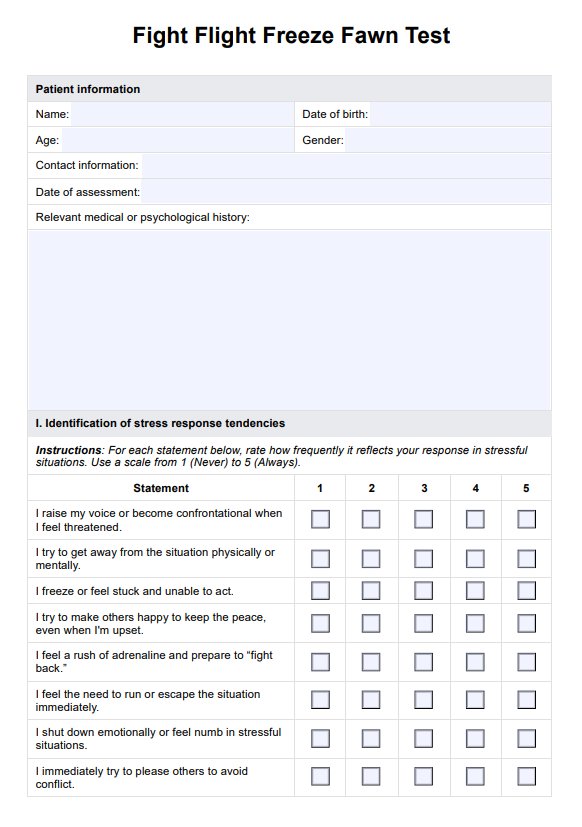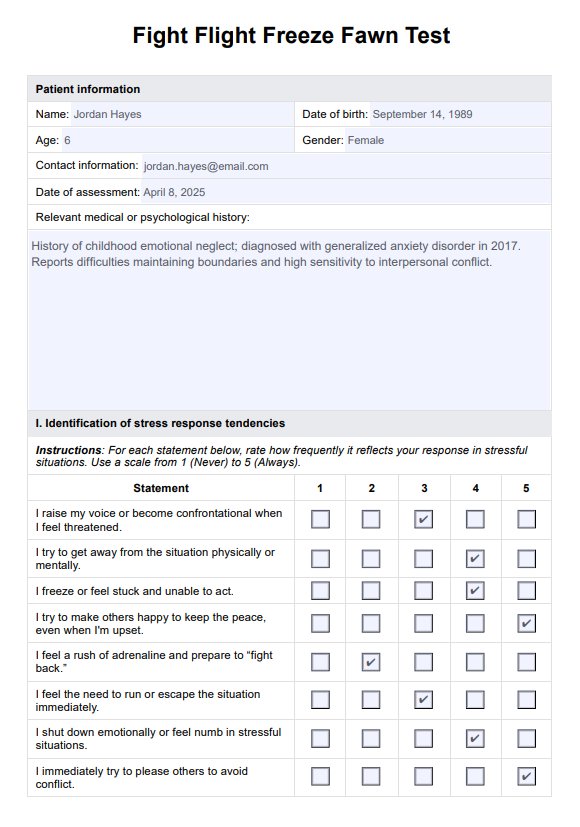Fight Flight Freeze Fawn Test
Download Carepatron's free Fight Flight Freeze Fawn Response PDF and example to help assess and understand patient response styles in clinical care.


What is a trauma response?
A trauma response is a set of physical, emotional, cognitive, and behavioral reactions that occur when the brain and body perceive a threat as overwhelming or inescapable (Substance Abuse and Mental Health Services Administration, 2014). It is the body’s way of reacting to what it determines as danger, activating the stress response to help the individual survive. This process can involve increased heart rate, changes in how the body feels, and shifts in behavior such as withdrawal or aggression. These responses often happen automatically and can leave individuals feeling stuck, especially when they repeatedly respond to stress in maladaptive ways.
Trauma responses may cause someone to avoid conflict, disengage from relationships, or experience confusion about what is happening. While these reactions are natural, they can interfere with functioning and relationships if they persist over time. Recognizing how trauma occurs and manifests is essential in clinical treatment planning, as the stress response can heavily influence how patients respond to therapy and daily life situations.
Fight Flight Freeze Fawn Test Template
Fight Flight Freeze Fawn Test Example
Types of trauma responses
Trauma responses are instinctive survival responses that the brain activates when a person perceives a serious threat. These responses help the individual deal with fear, danger, or harm. The four primary types—fight, flight, freeze, and fawn—are automatic reactions shaped by biology, past experiences, and context (Guy-Evans, 2023). Understanding how each type functions allows clinicians to identify patterns in behavior and develop trauma-informed strategies to support health, boundaries, and recovery.
Fight
The fight response activates when a person attempts to confront the threat's source directly. This trauma response is often associated with anger, defensiveness, or intense determination to act and regain control. Individuals in a fight response may appear tense, easily irritated, or reactive.
While it can be protective in immediate danger, it may become problematic if used in non-threatening situations, leading to conflict in relationships or health struggles. Clinicians should help patients identify when this survival response is helpful and when it causes more harm than good.
Flight
The flight response drives a person to avoid or escape perceived danger. This can manifest as restlessness, panic, or anxiety and may involve physical withdrawal or mental disengagement. People with a dominant flight response may struggle with chronic worry, trouble concentrating, or excessive activity as a way to cope. Breathing may become rapid, and the person may feel cold or overwhelmed.
While fleeing can be adaptive in real danger, it may lead to avoidance of everyday stressors. Identifying this pattern helps guide treatment toward building safe boundaries and healthy coping skills.
Freeze
The freeze response occurs when a person becomes immobilized in the face of trauma or fear. It is a biological shutdown mechanism in which the body and mind pause to avoid detection or reduce harm. Individuals in a freeze response may feel stuck, dissociated, numb, or disconnected. Physical signs include shallow breathing, a slowed heart rate, or feeling cold.
While this survival response may protect the person during overwhelming events, it often later interferes with action and communication. Treatment should focus on helping the person gently re-engage with sensations, emotions, and decision-making.
Fawn
The fawn response involves appeasing others to reduce the threat of conflict or rejection. A person in this mode may struggle to set boundaries, overextend themselves, or suppress their needs to maintain peace. This trauma response is typical in individuals with histories of relational trauma, where pleasing others was a learned survival tactic to avoid harm.
Fawning may look like compliance, excessive helpfulness, or fear of upsetting others. Clinicians can help individuals identify when this response is at play and work toward assertiveness, self-worth, and healthier relational patterns.
What is a Fight Flight Freeze Fawn Test?
Our Fight Flight Freeze Fawn Test helps assess an individual’s primary stress response pattern when exposed to perceived threats or high-pressure situations. It categorizes behavior into four instinctive responses—fight, flight, freeze, or fawn—through a combination of self-assessment items, scenario-based questions, physiological indicators, and clinician evaluation.
Our assessment helps healthcare professionals identify how a person typically reacts under stress, which is critical for trauma-informed care and treatment planning. By understanding dominant patterns and contextual factors, clinicians can better determine whether the response is adaptive or maladaptive, guide interventions, and tailor support strategies. Our template enables providers to gather comprehensive data across behavioral, emotional, and physiological domains, improving therapeutic outcomes for patients with trauma histories.
Benefits of using this test
The Fight Flight Freeze Fawn Test provides medical professionals with a structured, efficient method for assessing how patients respond to stress and perceived threats. It enhances trauma-informed care by identifying dominant behavioral patterns impacting clinical presentation, decision-making, and treatment engagement. This tool saves time during intake and ongoing evaluations by centralizing data collection in a single, easy-to-use format.
The test also improves documentation, making it easier to track patterns over time and justify clinical decisions. Using the template within Carepatron ensures consistency across assessments and integrates with other patient records, reducing administrative burden.
Most importantly, it enables targeted intervention planning by helping clinicians determine whether a patient’s stress responses are adaptive or maladaptive. This leads to more effective care strategies, better therapeutic outcomes, and improved patient-provider communication in trauma-related cases.
References
Guy-Evans, O. (2023, November 9). Fight, flight, freeze, or fawn: How we respond to threats. Simply Psychology. https://www.simplypsychology.org/fight-flight-freeze-fawn.html
Substance Abuse and Mental Health Services Administration. (2014). Understanding the impact of trauma. National Library of Medicine. https://www.ncbi.nlm.nih.gov/books/NBK207191/
Commonly asked questions
The four Fs of trauma response refer to Fight, Flight, Freeze, and Fawn—instinctive survival strategies the brain activates when a person perceives a threat. Each response influences behavior, emotion, and physiological reactions under stress.
Trauma is any event or experience that overwhelms an individual’s ability to cope, often resulting in lasting psychological, emotional, or physical distress. It can stem from a single incident or repeated exposure to threatening or harmful situations.
The shutdown response to trauma, often associated with the freeze response, involves becoming immobile or unresponsive when faced with extreme stress or danger. This can include physical rigidity, a mental shutdown, or a sense of numbness and detachment from the situation.





















-template.jpg)


















































































